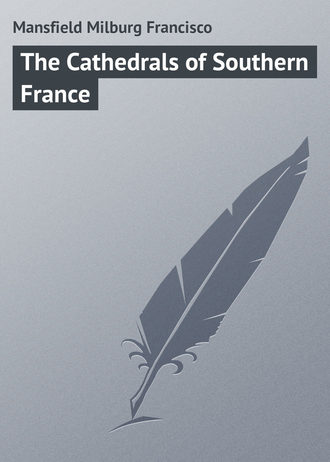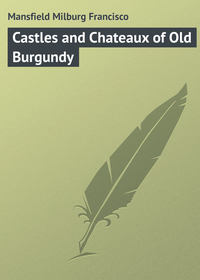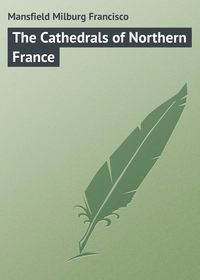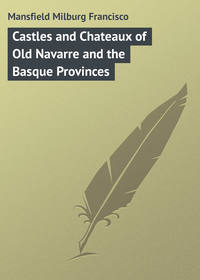 полная версия
полная версияThe Cathedrals of Southern France
The city conserves to-day somewhat of its ancient birthright, and is a picturesque and romantic spot, in which all may tarry awhile amid its tortuous streets and the splendid remains of its old-time builders. Few do drop off, even, in their annual rush southward, in season or out, and the result is that St. Paul Trois Châteaux is to-day a delightfully "old world" spot in the most significant meaning of the phrase.
Of course the habitant still refers to the seat of the former bishop's throne as a cathedral, and it is with pardonable pride that he does so.
This precious old eleventh and twelfth-century church is possessed of as endearing and interesting an aspect as the city itself. It has been restored in recent times, but is much hidden by the houses which hover around its walls. It has a unique portal which opens between two jutting columns whose shafts uphold nothing – not even capitals.
In fact, the general plan of the cathedral follows that of the Latin cross, though in this instance it is of rather robust proportions. The transepts, which are neither deep nor wide, are terminated with an apse, as is also the choir, which depends, for its embellishments, upon the decorative effect produced by eight Corinthian columns.
The interior, the nave in particular, is of unusual height for a not very grand structure; perhaps eighty feet. Its length is hardly greater.
The orders of columns rise vaultwards, surmounted by a simple entablature. These are perhaps not of the species that has come to be regarded as good form in Christian architecture, but which, for many reasons, have found their way into church-building, both before and since the rise of Gothic.
Under a triforium, in blind, is a sculptured drapery; again a feature more pagan than Christian, but which is here more pleasing than when usually found in such a false relation.
Both these details are in imitation of the antique, and, since they date from long before the simulating of pseudo-classical details became a mere fad, are the more interesting and valuable as an art-expression of the time.
For the rest, this one-time cathedral is uncommon and most singular in all its parts, though nowhere of very great inherent beauty.
An ancient gateway bears a statue of the Virgin. It was the gift of a former Archbishop of Paris to the town of his birth.
An ancient Dominican convent is now the École Normale des Petits Frères de Marie. Within its wall have recently been discovered a valuable mosaic work, and a table or altar of carved stone.
In the suburbs of the town have also recently been found much beautiful Roman work of a decorative nature; a geometric parchment in mosaic; a superb lamp, in worked bronze; a head of Mercury (now in the Louvre), and much treasure which would make any antiquarian literally leap for joy, were he but present when they were unearthed.
Altogether the brief résumé should make for a desire to know more of this ancient city whose name, even, is scarcely known to those much-travelled persons who cross and recross France in pursuit of the pleasures of convention alone.
PART IV
The Mediterranean Coast
I
INTRODUCTORY
The Mediterranean shore of the south of France, that delectable land which fringes the great tideless sea, bespeaks the very spirit of history and romance, of Christian fervour, and of profane riot and bloodshed.
Its ancient provinces, – Lower Languedoc, the Narbonensis of Gaul; Provence, the most glorious and golden of all that went to make up modern France, – the mediæval capital of King René, Aix-en-Provence, and the commercial capital of the Phoceans (559 B. C.), Massilia, all combine in a wealth of storied lore which is inexhaustible.
The tide of latter-day travel descends the Rhône to Marseilles, turns eastward to the conventional pleasures of the Riviera, and utterly neglects the charms of La Crau, St. Rémy, Martiques, and Aigues-Mortes; or the more progressive, though still ancient cathedral cities of Montpellier, Béziers, Narbonne, or Perpignan.
There is no question but that the French Riviera is, in winter, a land of sunshiny days, cool nights, and the more or the less rapid life of fashion. Which of these attractions induces the droves of personally-, semi-, and non-conducted tourists to journey thither, with the first advent of northern rigour, is doubtful; it is probably, however, a combination of all three.
It is a beautiful strip of coast-line from Marseilles to Mentone, and its towns and cities are most attractively placed. But a sojourn there "in the season," amid the luxury of a "palace-hotel," or the bareness of a mediocre pension, is a thing to be dreaded. Seekers after health and pleasure are supposed to be wonderfully recouped by the process; but this is more than doubtful. Vice is rarely attractive, but it is always made attractive, and weak tea and pain de ménage in a Riviera boarding-house are no more stimulating than elsewhere; hence the many virtues of this sunlit land are greatly nullified.
"A peculiarity of the Riviera is that each of the prominent watering-places possesses a tutelary deity of our own. (Modest this!) Thus, for instance, no visitor to Cannes is allowed to forget the name of Lord Brougham, while the interest at Beaulieu and Cap Martin centres around another great English statesman, Lord Salisbury. Cap d'Antibes has (or had) for its genius loci Grant Allen, and Valescure is chiefly concerned with Mrs. Humphry Ward and Mrs. Oliphant."
This quotation is, perhaps, enough to make the writer's point here: Why go to the Riviera to think of Lord Brougham, long since dead and gone, any more than to Monte Carlo to be reminded of the unfortunate end which happened to the great system for "breaking the bank" of Lord – , a nineteenth-century nobleman of notoriety – if not of fame?
The charm of situation of the Riviera is great, and the interest awakened by its many reminders of the historied past is equally so; but, with regard to its architectural remains, the most ready and willing temperament will be doomed to disappointment.
The cathedral cities of the Riviera are not of irresistible attraction as shrines of the Christian faith; but they have much else, either within their confines or in the immediate neighbourhood, which will go far to make up for the deficiency of their religious monuments.
It is not that the architectural remains of churches of another day, and secular establishments, are wholly wanting. Far from it; Fréjus, Toulon, Grasse, and Cannes are possessed of delightful old churches, though they are not of ranking greatness, or splendour.
Still the fact remains that, of themselves, the natural beauties of the region and the heritage of a historic past are not enough to attract the throngs which, for any one of a dozen suspected reasons, annually, from November to March, flock hither to this range of towns, which extends from Hyères and St. Raphael, on the west, to Bordighera and Ospadeletti, just over the Italian border, on the east.
It is truly historic ground, this; perhaps more visibly impressed upon the mind and imagination than any other in the world, if we except the Holy Land itself.
Along this boundary were the two main routes, by land and by water, through which the warlike and civil institutions of Rome first made their way into Gaul, conquered it, and impressed thereon indelibly for five hundred years the mighty power which their ambition urged forward.
At Cimiez, a suburb of Nice, they have left a well-preserved amphitheatre; at Antibes the remains of Roman towers; Villefranche – the port of Nice – was formerly a Roman port; Fréjus, the former Forum Julii, has remains of its ancient harbour, its city walls, an amphitheatre, a gateway, and an arch, and, at some distance from the city, the chief of all neighbouring remains, an aqueduct, the crumbling stones of which can be traced for many miles.
Above the promontory of Monaco, where the Alps abruptly meet the sea, stands the tiny village of La Turbie, some nineteen hundred feet above the waters of the sparklingly brilliant Mediterranean. Here stands that venerable ruined tower, the great Trophœa Augusti of the Romans, now stayed and strutted by modern masonry. It commemorates the Alpine victories of the first of the emperors, and overlooks both Italy and France. Stripped to-day of the decorations and sculptures which once graced its walls, it stands as a reminder of the first splendid introduction of the luxuriant architecture of Rome into the precincts of the Western Empire.
Here it may be recalled that sketching, even from the hilltops, is a somewhat risky proceeding for the artist. The surrounding eminences – as would be likely so near the Italian border – are frequently capped with a fortress, and occupied by a small garrison, the sole duty of whose commandant appears to be "heading off," or worse, those who would make a picturesque note of the environment of this ci-devant Roman stronghold. The process of transcribing "literary notes" is looked upon with equal suspicion, or even greater disapproval, in that – in English – they are not so readily translated as is even a bad drawing. So the admonition is here advisedly given for "whom it may concern."
From the Rhône eastward, Marseilles alone has any church of a class worthy to rank with those truly great. Its present cathedral of Ste. Marie-Majeure assuredly takes, both as to its plan and the magnitude on which it has been carried out, the rank of a masterwork of architecture. It is a modern cathedral, but it is a grand and imposing basilica, after the Byzantine manner.
Westward, if we except Béziers, where there is a commanding cathedral; Narbonne, where the true sky-pointing Gothic is to be found; and Perpignan, where there is a very ancient though peculiarly disposed cathedral, there are no really grand cathedral churches of this or any other day. On the whole, however, all these cities are possessed of a subtle charm of manner and environment which tell a story peculiarly their own.
Foremost among these cities of Southern Gaul, which have perhaps the greatest and most appealing interest for the traveller, are Carcassonne and Aigues-Mortes.
Each of these remarkable reminders of days that are gone is unlike anything elsewhere. Their very decay and practical desertion make for an interest which would otherwise be unattainable.
Aigues-Mortes has no cathedral, nor ever had; but Carcassonne has a very beautiful, though small, example in St. Nazaire, treated elsewhere in this book.
Both Aigues-Mortes and Carcassonne are the last, and the greatest, examples of the famous walled and fortified cities of the Middle Ages.
Aigues-Mortes itself is a mere dead thing of the marshes, which once held ten thousand souls, and witnessed all the pomp and glitter which attended upon the embarking of Louis IX. on his chivalrous, but ill-starred, ventures to the African coasts.
"Here was a city built by the whim of a king – the last of the Royal Crusaders." To-day it is a coffin-like city with perhaps a couple of thousand pallid, shaking mortals, striving against the marsh-fever, among the ruined houses, and within the mouldering walls of an ancient Gothic burgh.
II
ST. SAUVEUR D'AIX
Aix, the former capital of Provence, one of the most famous ancient provinces, the early seat of wealth and civilization, and the native land of the poetry and romance of mediævalism, was the still more ancient Aquæ Sextiæ of the Romans – so named for the hot springs of the neighbourhood. It was their oldest colony in Gaul, and was founded by Sextius Calvinus in B. C. 123.
In King René's time, – "le bon roi" died at Aix in 1480, —Aix-en-Provence was more famous than ever as a "gay capital," where "mirth and song and much good wine" reigned, if not to a degenerate extent, at least to the full expression of liberty.
In 1481, just subsequent to René's death, the province was annexed to the Crown, and fifty years later fell into the hands of Charles V., who was proclaimed King of Arles and Provence. This monarch's reign here was of short duration, and he evacuated the city after two months' tenure.
During all this time the church of Aix, from the foundation of the archbishopric by St. Maxine in the first century (as stated rather doubtfully in the "Gallia Christiania"), ever advanced hand in hand with the mediæval gaiety and splendour that is now past.
Who ever goes to Aix now? Not many Riviera tourists even, and not many, unless they are on a mission bent, will cross the Rhône and the Durance when such appealingly attractive cities as Arles, Avignon, and Nîmes lie on the direct pathway from north to south.
Formerly the see was known as the Province of Aix. To-day it is known as Aix, Arles, and Embrun, and covers the Department of Bouches-du-Rhône, with the exception of Marseilles, which is a suffragan bishopric of itself.
The chief ecclesiastical monuments of Aix are the cathedral of St. Sauveur, with its most unusual baptistère; the church of St. Jean-de-Malte of the fourteenth century; and the comparatively modern early eighteenth-century church of La Madeleine, with a fine "Annunciation" confidently attributed by local experts to Albrecht Dürer.
The cathedral of St. Sauveur is, in part, an eleventh-century church. The portions remaining of this era are not very extensive, but they do exist, and the choir, which was added in the thirteenth century, made the first approach to a completed structure. In the next century the choir was still more elaborated, and the tower and the southern aisle of the nave added. This nave is, therefore, the original nave, as the northern aisle was not added until well into the seventeenth century.
The west façade contains a wonderful, though non-contemporary, door and doorway in wood and stone of the early sixteenth century. This doorway is in two bays, divided by a pier, on which is superimposed a statue of the Virgin and Child, framed by a light garland of foliage and fruits. Above are twelve tiny statuettes of Sibylles or the theological virtues placed in two rows. The lower range of the archivolt is divided by pilasters bearing the symbols of the Evangelists, deeply cut arabesques of the Genii, and the four greater prophets – Isaiah, Jeremiah, Ezekiel, and Daniel.
Taken together, these late sculptures of the early sixteenth century form an unusually mixed lot; but their workmanship and disposition are pleasing and of an excellence which in many carvings of an earlier date is often lacking.
The interior shows early "pointed" and simple round arches, with pilasters and pediment which bear little relation to Gothic, and are yet not Romanesque of the conventional variety. These features are mainly not suggestive of the Renaissance either, though work of this style crops out, as might be expected, in the added north aisle of the nave.
The transepts, too, which are hardly to be remarked from the outside, – being much hemmed about by the surrounding buildings, – also indicate their Renaissance origin.
The real embellishments of the interior are: a triptych – "The Burning Bush," with portraits of King René, Queen Jeanne de Laval, and others; another of "The Annunciation;" a painting of St. Thomas, by a sixteenth-century Flemish artist; and some sixteenth-century tapestries. None of these features, while acceptable enough as works of art, compare in worth or novelty with the tiny baptistère, which is claimed as of the sixth century.
This is an unusual work in Gaul, the only other examples being at Poitiers and Le Puy. It resembles in plan and outline its more famous contemporary at Ravenna, and shows eight antique columns, from a former temple to Apollo, with dark shafts and lighter capitals. The dome has a modern stucco finish, little in keeping with the general tone and purport of this accessory. The cloister of St Sauveur, in the Lombard style, is very curious, with its assorted twisted and plain columns, some even knotted. The origin of its style is again bespoke in certain of the round-headed arches. Altogether, as an accessory to the cathedral, if to no other extent, this Lombard detail is forceful and interesting.
III
ST. REPARATA DE NICE
"What would you, then? I say it is most engaging, in winter when the strangers are here, and all work day and night; but it is a much better place in summer, when one can take their ease."
– Paul Arène.Whatever may be the attractions of Nice for the travelled person, they certainly do not lie in or about its cathedral. The guide-books call it simply "the principal ecclesiastical edifice … of no great interest," which is an apt enough qualification.
In a book which professes to treat of the special subject of cathedral churches, something more is expected, if only to define the reason of the lack of appealing interest.
One might say with the Abbé Bourassé, – who wrote of St. Louis de Versailles, – "It is cold, unfeeling, and without life;" or he might dismiss it with a few words of lukewarm praise, which would be even less satisfying.
More specifically the observation might be passed that the lover of churches will hardly find enough to warrant even passing consideration on the entire Riviera.
This last is in a great measure true, though much of the incident of history and romance is woven about what – so far as the church-lover is concerned – may be termed mere "tourist points."
At all events, he who makes the round, from Marseilles to San Remo in Italy, must to no small extent subordinate his love of ecclesiastical art and – as do the majority of visitors – plunge into a whirl of gaiety (sic) as conventional and unsatisfying as are most fulsome, fleeting pleasures.
The sensation is agreeable enough to most of us, for a time at least, but the forced and artificial gaiety soon palls, and he who puts it all behind him, and strikes inland to Aix and Embrun and the romantically disposed little cathedral towns of the valley of the Durance, will come once again into an architectural zone more in comport with the subject suggested by the title of this book.
It is curious to note that, with the exception of Marseilles and Aix, scarce one of the suffragan dioceses of the ancient ecclesiastical province of Aix, Arles, and Embrun is possessed of a cathedral of the magnitude which we are wont to associate with the churchly dignity of a bishop.
St. Reparata de Nice is dismissed as above; that of Antibes was early transferred or combined with that of Grasse; Grasse itself endured for a time – from 1245 onward – but was suppressed in 1790; Glandève, Senez, and Riez were combined with Digne; while Fréjus has become subordinate to Toulon, though it shares episcopal dignity with that city.
In spite of these changes and the apparently inexplicable tangle of the limits of jurisdiction which has spread over this entire region, religion has, as might be inferred from a study of the movement of early Christianity in Gaul, ever been prominent in the life of the people, and furthermore is of very long standing.
The first bishop of Nice was Amantius, who came in the fourth century. With what effect he laboured and with what real effect his labours resulted, history does not state with minutiæ. The name first given to the diocese was Cemenelium.
In 1802 the diocese of Nice was allied with that of Aix, but in the final readjustment its individuality became its own possession once more, and it is now a bishopric, a suffragan of Marseilles.
As to architectural splendour, or even worth, St. Reparata de Nice has none. It is a poor, mean fabric in the Italian style; quite unsuitable in its dimensions to even the proper exploitation of any beauties that the style of the Renaissance may otherwise possess.
The general impression that it makes upon one is that it is but a makeshift or substitute for something more pretentious which is to come.
The church dates from 1650 only, and is entirely unworthy as an expression of religious art or architecture. The structure itself is bare throughout, and what decorative embellishments there are – though numerous – are gaudy, after the manner of stage tinsel.
IV
STE. MARIE MAJEURE DE TOULON
The episcopal dignity of Toulon is to-day shared with Fréjus, whereas, at the founding of the diocese, Toulon stood alone as a bishopric in the ecclesiastical province of Arles. This was in the fifth century. When the readjustment came, after the Revolution, the honour was divided with the neighbouring coast town of Fréjus.
In spite of the fact that the cathedral here is of exceeding interest, Toulon is most often thought of as the chief naval station of France in the Mediterranean. From this fact signs of the workaday world are for ever thrusting themselves before one.
As a seaport, Toulon is admirably situated and planned, but the contrast between the new and old quarters of the town and the frowning fortifications, docks, and storehouses is a jumble of utilitarian accessories which does not make for the slightest artistic or æsthetic interest.
Ste. Marie Majeure is a Romanesque edifice of the eleventh and twelfth centuries. Its façade is an added member of the seventeenth century, and the belfry of the century following. The church to-day is of some considerable magnitude, as the work of the seventeenth and eighteenth centuries comprehended extensive enlargements.
As to its specific style, it has been called Provençal as well as Romanesque. It is hardly one or the other, as the pure types known elsewhere are considered, but rather a blend or transition between the two.
The edifice underwent a twelfth-century restoration, which doubtless was the opportunity for incorporating with the Romanesque fabric certain details which we have come since to know as Provençal.
During the Revolution the cathedral suffered much despoliation, as was usual, and only came through the trial in a somewhat imperfect and poverty-stricken condition. Still, it presents to-day some considerable splendour, if not actual magnificence.
Its nave is for more reasons than one quite remarkable. It has a length of perhaps a hundred and sixty feet, and a width scarcely thirty-five, which gives an astonishing effect of narrowness, but one which bespeaks a certain grace and lightness nevertheless – or would, were its constructive elements of a little lighter order.
In a chapel to the right of the choir is a fine modern reredos, and throughout there are many paintings of acceptable, if not great, worth. The pulpit, by a native of Toulon, is usually admired, but is a modern work which in no way compares with others of its kind seen along the Rhine, and indeed throughout Germany. One of the principal features which decorate the interior is a tabernacle by Puget; while an admirable sculptured "Jehovah and the Angels" by Veyrier, and a "Virgin" by Canova – which truly is not a great work – complete the list of artistic accessories.
The first bishop of Toulon, in the fifth century, was one Honoré.
V
ST. ETIENNE DE FRÉJUS
The ancient episcopal city of Fréjus has perhaps more than a due share of the attractions for the student and lover of the historic past. It is one of the most ancient cities of Provence. Its charm of environment, people, and much else that it offers, on the surface or below, are as irresistible a galaxy as one can find in a small town of scarce three thousand inhabitants. And Fréjus is right on the beaten track, too, though it is not apparent that the usual run of pleasure-loving, tennis-playing, and dancing-party species of tourist – at a small sum per head, all included – ever stop here en route to the town's more fashionable Riviera neighbours – at least they do not en masse– as they wing their way to the more delectable pleasures of naughty Nice or precise and proper Mentone.
The establishment of a bishopric here is somewhat doubtfully given by "La Gallia Christiania" as having been in the fourth century. Coupled with this statement is the assertion that the cathedral at Fréjus is very ancient, and its foundation very obscure; but that it was probably built up from the remains of a "primitive temple consecrated to an idol." Such, at least, is the information gleaned from a French source, which does not in any way suggest room for doubt.









